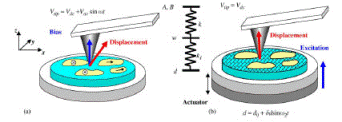Department of Physics and Astronomy: Publications and Other Research
Date of this Version
February 2001
Abstract
The nanoscale mechanism of retention behavior in SrBi2Ta2O9 (SBT) thin films has been investigated by means of piezoresponse scanning force microscopy. It has been found that SBT films with Pt electrodes (SBT/Pt) exhibit a strong dependence of retention characteristics upon domain polarity: positive domains with the polarization vector pointing to the bottom electrode exhibit excellent stability in sharp contrast to the negative domains which show poor retention. The backswitching of the negative domains proceeds via sidewise motion of the domain walls and shows a log-time dependence. The strong effect of the poling voltage parameters (duration and amplitude) and the previous switching pattern on domain retention behavior is reported. On the other hand, in SBT films with IrO2 electrodes (SBT/IrO2), the written domains of both polarities show no sign of relaxation to the original state irrespective of the parameters of the poling voltage. The difference in retention behavior of opposite domains in SBT/Pt films is explained by the presence of the polarization-independent built-in bias at the SBT/Pt interface pointing to the bottom electrode. This built-in bias triggers the backswitching of a negative domain by generating positive nuclei at the interface. The forward growth of the nuclei is further governed by the field of the space charge which screens the original polarization state. The symmetric retention behavior and the stability of domain in SBT films with IrO2 electrodes are attributed to the inhibition of the nucleation process at the SBT/IrO2 interface.


Comments
Published in J. Appl. Phys., Vol. 89, No. 3, 1 February 2001. Copyright © 2001 American Institute of Physics. Used by permission.